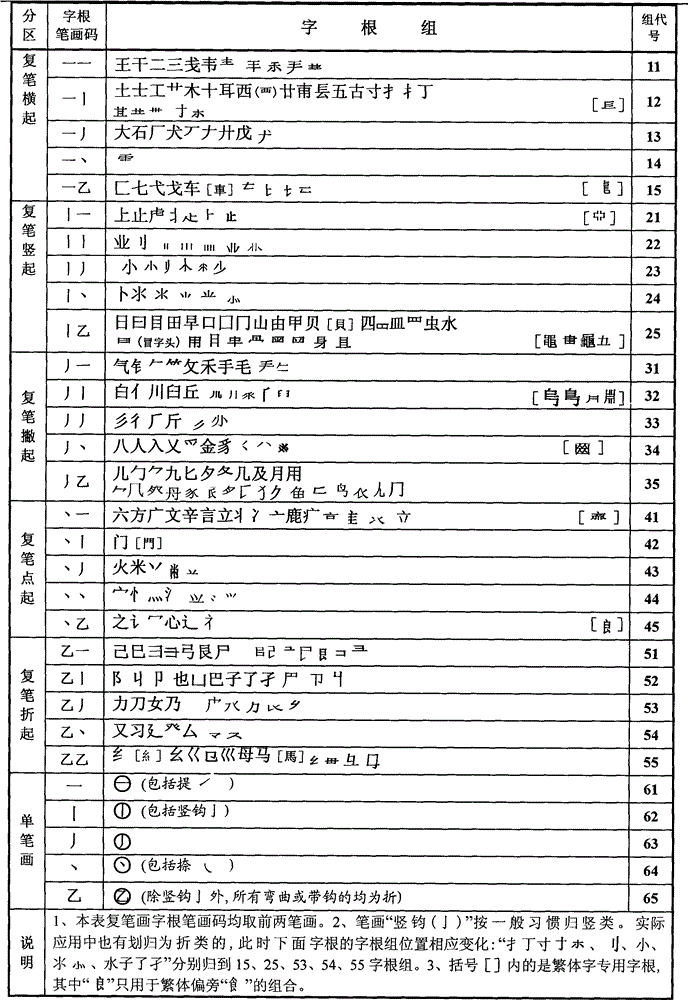Method for inputting Chinese characters by utilizing etymon stroke codes
A stroke code and radical technology, which is applied in the field of inputting Chinese characters by using the radical stroke code, can solve the problems of incapable of mixed coding of words, affecting efficiency, awkwardness and the like
- Summary
- Abstract
- Description
- Claims
- Application Information
AI Technical Summary
Problems solved by technology
Method used
Image
Examples
Embodiment 1
[0135] This embodiment is mainly applied to numeric keyboards, and its keyboard design is as follows: Figure 11 As shown, it uses figure 1 The radical system shown does not perform any optimization and adjustment on the key position of the radical. It includes 30,000 commonly used phrases, 1980 single-word repeated code words, and a static repeated code rate of 29.28%.
[0136] Shortcode settings. 84.3% of the characters (5704 characters) in the 6763 character library have set brevity codes, and there are 10749 brevity codes in all. Among them, there are 6 short codes for one key: "1-2 is 3, 4 is not 5, and 6 is yes", and there are 30 short codes for two keys: "11 is now 12, 13 is 14, 15 or 21, 22, 23, 24 is 25 Middle 31 and 32 he 33 very 34 people 35 use 41 this 42 asked 43 with 44 it 45 said 51 had 52 out 53 that 54 pairs of 55 child 61 and 62 old 63 I 64 is 65 ", three-key brevity code 169: "111 Ring 112 Reason 113 No 114 Violation 115 Cloud...654 Buy 655 Water 656 Sen...
Embodiment 2
[0144] This embodiment is a further optimization of Embodiment 1, that is, adopting such Figure 32 Shown " large radical scheme ", other situations are all the same as embodiment 1. The number of single-word repeated codes is 1992, and the static repeated code rate is 29.45%. Compared with Embodiment 1, the repeated codes increase very little, and basically have no influence on performance. Because it adopts the "big radical scheme", it is easy to split characters, and the response to split characters is fast. It is easier to type, and the actual efficiency is higher.
Embodiment 3
[0146] This embodiment is mainly applied to large keyboards, and its keyboard design is as follows: Figure 18 As shown, it uses figure 1 The root system shown. single stroke radical Input with the same key of 11, 22, 31, 42, 51 radical groups respectively, simultaneously in 11 radical groups and The "two" and "three" with poor compatibility are transferred to the V key and the S key respectively.
[0147] The optimization and adjustment of this embodiment adopts the pure "internal adjustment" method, according to the statistical data of the compatibility characteristics of the radicals and their dynamic frequencies, the partial high-repetition code radicals and the second-highest repetition code radicals are adjusted to the appropriate key position, that is, the dynamic frequency The higher the key, the easier it is to hit, so that the layout of the keyboard radicals can achieve a better unity of low repetition code and comfortable coordination:
[0148] 1. Adjustment o...
PUM
 Login to View More
Login to View More Abstract
Description
Claims
Application Information
 Login to View More
Login to View More - R&D
- Intellectual Property
- Life Sciences
- Materials
- Tech Scout
- Unparalleled Data Quality
- Higher Quality Content
- 60% Fewer Hallucinations
Browse by: Latest US Patents, China's latest patents, Technical Efficacy Thesaurus, Application Domain, Technology Topic, Popular Technical Reports.
© 2025 PatSnap. All rights reserved.Legal|Privacy policy|Modern Slavery Act Transparency Statement|Sitemap|About US| Contact US: help@patsnap.com



